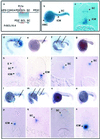Regulation of the stem cell leukemia (SCL) gene: a tale of two fishes
- PMID: 11381108
- PMCID: PMC34424
- DOI: 10.1073/pnas.101532998
Regulation of the stem cell leukemia (SCL) gene: a tale of two fishes
Abstract
The stem cell leukemia (SCL) gene encodes a tissue-specific basic helix-loop-helix (bHLH) protein with a pivotal role in hemopoiesis and vasculogenesis. Several enhancers have been identified within the murine SCL locus that direct reporter gene expression to subdomains of the normal SCL expression pattern, and long-range sequence comparisons of the human and murine SCL loci have identified additional candidate enhancers. To facilitate the characterization of regulatory elements, we have sequenced and analyzed 33 kb of the SCL genomic locus from the pufferfish Fugu rubripes, a species with a highly compact genome. Although the pattern of SCL expression is highly conserved from mammals to teleost fish, the genes flanking pufferfish SCL were unrelated to those known to flank both avian and mammalian SCL genes. These data suggest that SCL regulatory elements are confined to the region between the upstream and downstream flanking genes, a region of 65 kb in human and 8.5 kb in pufferfish. Consistent with this hypothesis, the entire 33-kb pufferfish SCL locus directed appropriate expression to hemopoietic and neural tissue in transgenic zebrafish embryos, as did a 10.4-kb fragment containing the SCL gene and extending to the 5' and 3' flanking genes. These results demonstrate the power of combining the compact genome of the pufferfish with the advantages that zebrafish provide for studies of gene regulation during development. Furthermore, the pufferfish SCL locus provides a powerful tool for the manipulation of hemopoiesis and vasculogenesis in vivo.
Figures




Comment in
-
Mapping of complex regulatory elements by pufferfish/zebrafish transgenesis.Proc Natl Acad Sci U S A. 2001 Jun 5;98(12):6540-2. doi: 10.1073/pnas.131199098. Proc Natl Acad Sci U S A. 2001. PMID: 11390989 Free PMC article. No abstract available.
Similar articles
-
Mapping of complex regulatory elements by pufferfish/zebrafish transgenesis.Proc Natl Acad Sci U S A. 2001 Jun 5;98(12):6540-2. doi: 10.1073/pnas.131199098. Proc Natl Acad Sci U S A. 2001. PMID: 11390989 Free PMC article. No abstract available.
-
Transcriptional regulation of the stem cell leukemia gene (SCL)--comparative analysis of five vertebrate SCL loci.Genome Res. 2002 May;12(5):749-59. doi: 10.1101/gr.45502. Genome Res. 2002. PMID: 11997341 Free PMC article.
-
Analysis of vertebrate SCL loci identifies conserved enhancers.Nat Biotechnol. 2000 Feb;18(2):181-6. doi: 10.1038/72635. Nat Biotechnol. 2000. PMID: 10657125
-
The helix-loop-helix gene SCL: implicated in T-cell acute lymphoblastic leukaemia and in normal haematopoietic development.Int J Biochem Cell Biol. 1996 Jun;28(6):609-18. doi: 10.1016/1357-2725(96)00006-4. Int J Biochem Cell Biol. 1996. PMID: 8673726 Review.
-
The stem cell leukaemia (SCL) gene: a critical regulator of haemopoietic and vascular development.Int J Biochem Cell Biol. 1999 Oct;31(10):1193-207. doi: 10.1016/s1357-2725(99)00082-5. Int J Biochem Cell Biol. 1999. PMID: 10582347 Review. No abstract available.
Cited by
-
Expression profiling and comparative genomics identify a conserved regulatory region controlling midline expression in the zebrafish embryo.Genome Res. 2004 Feb;14(2):228-38. doi: 10.1101/gr.1819204. Epub 2004 Jan 12. Genome Res. 2004. PMID: 14718378 Free PMC article.
-
Mapping of complex regulatory elements by pufferfish/zebrafish transgenesis.Proc Natl Acad Sci U S A. 2001 Jun 5;98(12):6540-2. doi: 10.1073/pnas.131199098. Proc Natl Acad Sci U S A. 2001. PMID: 11390989 Free PMC article. No abstract available.
-
Impaired in vitro erythropoiesis following deletion of the Scl (Tal1) +40 enhancer is largely compensated for in vivo despite a significant reduction in expression.Mol Cell Biol. 2013 Mar;33(6):1254-66. doi: 10.1128/MCB.01525-12. Epub 2013 Jan 14. Mol Cell Biol. 2013. PMID: 23319051 Free PMC article.
-
Functional diversification of sonic hedgehog paralog enhancers identified by phylogenomic reconstruction.Genome Biol. 2007;8(6):R106. doi: 10.1186/gb-2007-8-6-r106. Genome Biol. 2007. PMID: 17559649 Free PMC article.
-
Ancient duplicated conserved noncoding elements in vertebrates: a genomic and functional analysis.Genome Res. 2006 Apr;16(4):451-65. doi: 10.1101/gr.4143406. Epub 2006 Mar 13. Genome Res. 2006. PMID: 16533910 Free PMC article.
References
Publication types
MeSH terms
Substances
Grants and funding
LinkOut - more resources
Full Text Sources
Molecular Biology Databases
Research Materials
Miscellaneous

